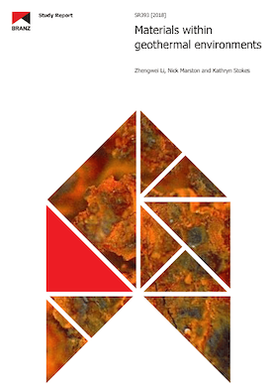
SR393 Materials within geothermal environments (2018)
Product Description
New Zealand has numerous geothermal systems, particularly in the central part of the North Island. Geothermal emissions with sulphur-containing gas species, such as hydrogen sulphide and sulphur dioxide, can be aggressive towards susceptible building and construction materials. These may include metals, timbers, paints and composites. Current information on how materials perform in geothermal environments is limited, which makes specific engineering design (SED), required by NZS 3604:2011 Timber-framed buildings, difficult.
This study summarises the results derived from BRANZ short-term field exposure testing in Rotorua – a population centre with known geothermal influences on the performance and durability of materials, buildings and infrastructure assets. It basically covers two experimental aspects – environmental monitoring and degradation analysis of several metals and timbers.
This study reveals that atmospheric corrosion of metals in geothermal environments can be very different from those in other New Zealand environments, such as marine, industrial and rural. These are shown as extremely high corrosion rates and unusual degradation kinetics. These behaviours are challenging environmental corrosivity classification using model metals according to ISO 9223:2012 Corrosion of metals and alloys – Corrosivity of atmospheres – Classification, determination and estimation and service-life estimation based on short-term performance monitoring data.
This study suggests it would be necessary to perform long-term, systematic monitoring and testing of performance and durability of representative building materials and protective coating systems, particularly in areas with high concentrations of geothermal sulphur-containing species. Data, information and knowledge derived will benefit the building and construction industry and strongly support its safe practice in geothermal environments.
See the BRANZ Research Now for a short and accessible summary of this report
Product Information
| Publication date | July 2018 |
|---|---|
| Author | Zhengwei Li, Nick Marston and Kathryn Stokes |
| System number | SR393 |